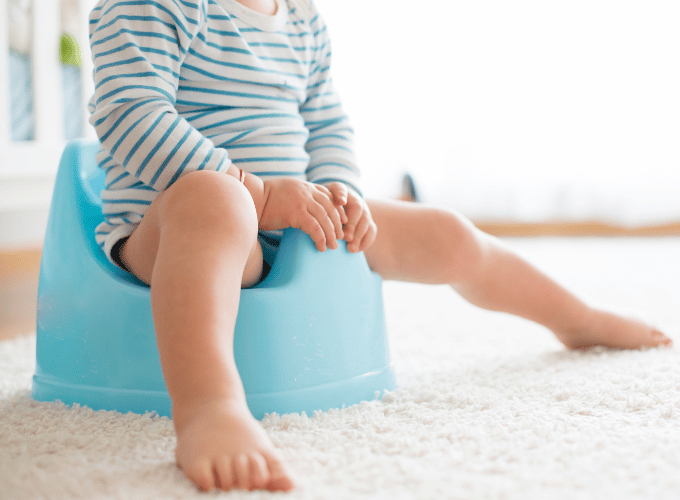Interoception and toileting
What is Interoception?
Interoception is our eighth sense which responds to signals and sensations from inside our bodies.
It describes how we feel and interpret the signals from our internal body organs, such as hunger, tummy sensation from digestion, heart rate, breathing, feeling that the bladder is full, and when we need to poo.
Our other senses are:
- Sight
- Hearing
- Touch
- Taste
- Smell
- Proprioception (understanding where our body is and how it moves)
- Vestibular (balance and spatial orientation)
Understanding what our body is telling us
In the same way children learn to understand sounds and speech, young children gradually learn to notice and understand the messages they receive from their bodies.
All children are different however and some children find it easier to learn and understand these sensations and what they mean than others.
The different ways children can experience their body's signals include:
- Too small. Some children don’t notice them so much at first, and only gradually become aware of these and start to understand what the messages mean and what their body is doing.
- Too big. Some children have increased sensation - they can find their body signals uncomfortable and upsetting.
- Distorted feelings. Their body signals are noticeable, but they're not able to be specific
about the location or type of feeling.
Interoception and toilet training
There is evidence that some children learn to recognise their body signals of a full bladder and bowel after they learn to use the potty and toilet and have developed a toileting routine.
Current thinking suggests that it is not necessary to wait until children show signs that they recognise they are weeing or pooing, but that a regular toileting routine can help them learn to use a toilet or potty and the awareness of their body sensation can sometimes be understood and responded to afterwards.
We can’t know exactly what a child is feeling, but we can understand a great deal by watching their behaviour and responses.
If children understand and notice how their body feels they can then begin to respond to their physical needs, including learning toileting skills.
How does Interoception work?
We all have sensory receptors in all our internal organs and muscles. These respond to sensations experienced and create a stimulus that is transmitted along the nerve fibres to the brain. There it connects with other sensations, memory and knowledge and the brain make sense of these messages.
In this way we learn how our body feels and it helps us to know when we are tired, excited, hungry, and need the toilet. This can connect to parts of the brain that make decisions and stimulate our body to respond.
Interoception and toilet training tips:
Understanding messages from their body helps children with toilet training. Learning how to link the signals from their bodies with their bowel and bladder actions can be really helpful for them.
Here are some tips for including this as part of your child’s learning process to get clean and dry:
- Teach your child how their body makes wee and poo and how it tells them when it needs to come out.
- Instead of asking if they want to go to the toilet, ask if they can feel any wee or poo that wants to go in the toilet? This will help them make sense of the messages they are receiving.
- Pictures and videos on how the body works and the bowel and bladder are fun and make sense of why we use the toilet.
- Include body awareness to help children understand the messages from their bowel and bladder
Identify if children are having difficulty learning Interoception messages and take this into account. A sensory assessment may be helpful.
Interoception and constipation
Constipation is very common in children. It can be uncomfortable and is often painful.
Children’s awareness of these sensations often can make them afraid of pooing. This can cause children to withhold their poo to avoid the discomfort and the frightening sensations. This makes the constipation worse.
It is important to treat the constipation effectively, but we also need to understand how a child is feeling and interpreting the messages from their intestine and body.
We need to evaluate and respond to their feelings and anxieties. We need to address the constipation, and at the same time include strategies to help with their understanding of body sensations and help the anxiety linked these feelings.
Emotional understanding and Interoception
Emotions such as anxiety and excitement can stimulate the functioning of internal organs, and this is linked to hormonal effects caused by adrenaline.
Our body sensations are very closely linked to our feelings and emotions. Anxiety causes a rapid heart rate, and increased shallow breathing, as well as sometimes affecting digestion.
Many of our body’s reactions help people to notice and understand emotions including feelings of tension and relaxation.
These feelings can sometimes be confusing and worrying and can sometimes be linked to difficulties with control of the bowel and bladder.
There is increasing understanding about the complex interaction of body signals, emotions and learning in children.
It is important to understand the impact of internal sensations on children’s toilet training and take these into consideration to tailor programmes to meet their specific needs.
We are also learning more about this and this will be helpful for children and families in future.
Children with autism
Autistic children with sensory difficulties may have more difficulty in understanding and noticing their body signals. It can take them longer to make sense of what they mean. If this is not appreciated it can be mistaken for laziness or lack of co-operation.
These children may need more help and prompts to achieve a reliable awareness of toileting needs and become clean and dry.
They do usually achieve this, but it may be more difficult and they often need more support.
How to help children understand their sensations
- Identify and understand how a child is feeling and responding
- Talk to children and help them understand how their body is feeling.
- Help them understand how their body works, videos, pictures and stories can help
- Help them to understand the difference between the feelings of normal bowel activity, discomfort and pain
- Explore the size of pain and discomfort, with showing with their hands the size; score out of 10-; a bit, a lot, loads, huge.
- If children are having difficulty noticing and understanding their body sensations:
- Link body feelings to routines and other activities, e.g. we sit on the toilet before football, or play time.
- Use other cues reminders and prompts e.g. picture cues alarms, vibrating watches
- Reward effort as much as success
Older children and teenagers
Body awareness can cause problem for older children. It is never too late to help children tune into their body sensations.
Ways to do this include:
Talking to your child and helping them practice noticing how their body is feeling.
Some children enjoy the ‘be a scientist’ approach to keep a record of their wee and poo and their sensations, which may help their understanding.
Help may be needed for some such as with timers or visual cues, and reminders linked to day time routines.
Body awareness signals may be more difficult to notice as social and educational demands increase as young people grow older. Increased internal body signals can also occur with anxiety, especially about toilets and be linked to holding in the wee and poo, or sometimes going to the toilet more often. Understanding this can be helpful to work out solutions.
Research has found that children don’t receive as many sensations from neurological receptor stimuli in the brain when they are absorbed in activities, such as when playing on computer games.
This may be linked to the body awareness sensations being more subtle. Sensations from inside our bodies may not be as intense as other sensations and may be more difficult to notice.
A 5 minute video from Kelly Mahler which gives an overview explanation of interoception.
An 11 minute video from Kelly Mahler exploring intereception in more detail.
Useful websites
- Kelly Mahler's website about interoception
- The Explosive Child - Dr Ross Greene
- Bladder & Bowel UK - bladder and bowel problems information and advice
- Sensory Processing Disorder Support
- Groups on Facebook (type 'interoception' into the search box).
Further help
If you have any questions or worries about your child’s continence seek advice from you 0-19 service or GP who can support or sign post you to the correct services.
Upcoming events
Share this page
Almost all children can learn to be clean and dry. Get information and support for helping your child to make the transition from nappies to pants.
Children with autism or a learning disability are more likely to have tummy problems and become constipated. Find out why and get tips to help.
Many people, of all ages, find toilets unpleasant and sometimes worrying. It is particularly common in children and can impact on their bowel and bladder control and function.



